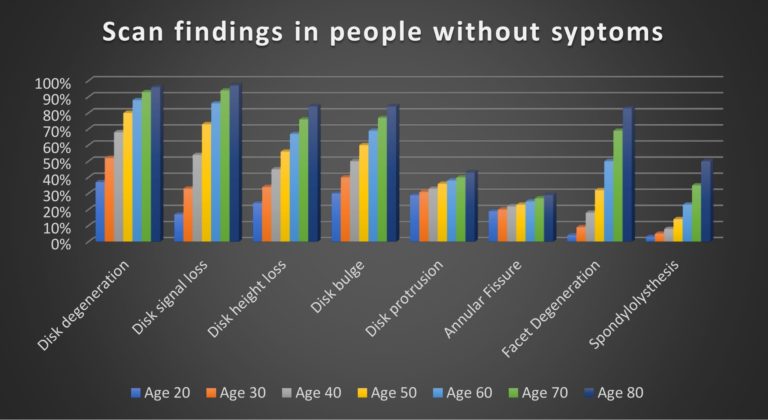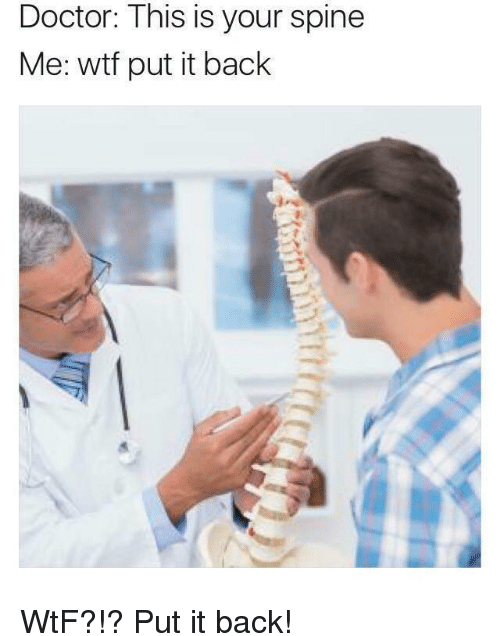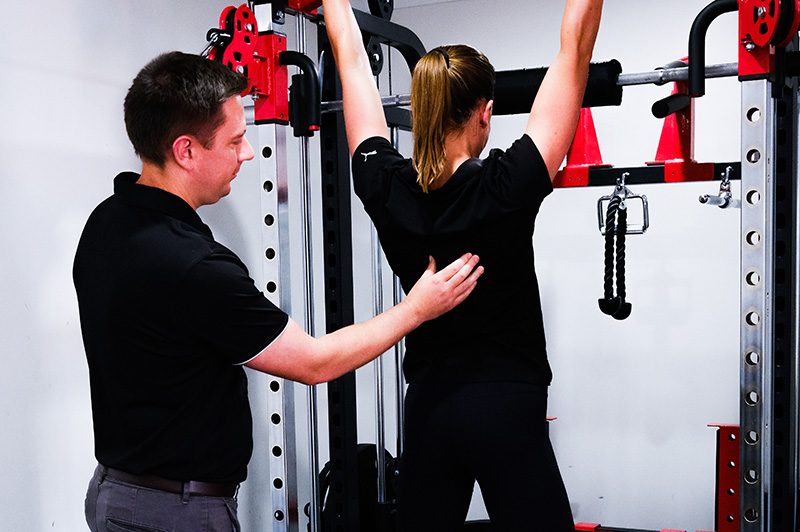Welcome back to this series of blogs on low back pain. Before going any further I strongly recommend that you read the first few blogs on this topic here and here. This will help set the scene for what we are about to discuss today as there are links between interpreting scan report findings and how we can interpret low back pain.
So, if you read “to scan or not to scan” you will know that physical changes in the back do not correlate very well with pain. If you missed it, below is the bar chart that summarises the findings from Brinjikji et al.

Here we can see that changes such as disc bulges and loss of disc height are quite normal amongst people that don’t have symptoms. That’s not to say that these changes are irrelevant, but they need to be considered in the context of a full examination of the patient. If there are correlations in findings between a clinical examination and scan reports, then it increases the likelihood of the specific anatomical feature being relevant but doesn’t necessarily mean that they are causative.
Plus, we know that in most cases of low back pain it is very difficult to pin point a specific anatomical cause.
So, the question that we get asked a lot from patients is: have I damaged my back, and will I damage my back further?
Firstly, we need to address the term “damage”. Damage implies that something is broken, torn or ripped. Now let’s put that into the context of low back pain with a few examples. A disc bulge is a mis-shaped disc. Not torn, broken or damaged but just a little different in shape to what would be considered anatomically normal. Reduced disk height is very much the same. Even the scariest word “spondylolisthesis” is nothing more than a forward movement of one vertebra on another and has often been present for years before people pick it up on a scan. So, in reality, a lot of these terms that you might discuss with your physio or other health professional aren’t actually damage at all. They are simply anatomical changes. Some of which might contribute to pain but some of which won’t.
To damage your back, we are talking about some serious force such as a fall or significant accident. Then you might have fractures or disc herniation’s (this is where the disc in torn) but amazingly people that experience these kinds of injuries also report varying levels of pain- some even present with no pain at all! However, there are specific questions and tests that your health professional will ask you that will help to determine whether you have truly damaged your back or not. But keep in mind that pain doesn’t correlate well with tissue damage.
So, do we need to be worried about these changes that happen in our back (disc bulges etc.)? Well the option is yours. You could worry about it if you like. But my question would be: what is the point in worrying about something that you can’t change? I would suggest focusing on other factors such as movement, exercises, strength, sleep, reducing stress and reducing anxiety. These are factors that you can control and will likely have a positive impact on your back pain regardless of what anatomical structures are involved.
And in terms of causing more damage? Well there isn’t any evidence to suggest that day to day movements are going to cause any damage to your back at all. In fact, your back is amazingly strong and robust. In all honesty, we should have more faith in our backs. A whole industry has grown out of the false premise that our backs are weak. But when you look at the scientific literature there isn’t much to suggest that specific movements such as bending are likely to result in pain or damage. In fact, in my experience working for over 10 years as a physio I have only seen a handful of people that have experienced low back pain after lifting a heavy object- and they all had great outcomes within 4-6 weeks. Of course, it is possible to hurt yourself lifting heavy objects but probably nowhere near as likely as it is thought to be in the public domain.
So, what about the people who have had their back “put back into place” by a health professional? Surely, if something is out of place that isn’t good? Well, quite simply, this is extremely lazy language that implies that something is out of place and needs to be put back in. Trust me on this one- your back is not out of place. If it was, you would need more than a physio/chiro/osteo/GP to help you out. In fact, you’d be straight down to ED (and you wouldn’t be walking) and would be looking at some serious long-term health implications.

This begs the question- why do people use that language then? Sadly, I don’t have a good answer. Maybe historically it was genuinely believed that we were putting things back in place. But the reality is that the noise you hear during a manipulation or adjustment (another rubbish term- you aren’t adjusting anything) is simply gas being pushed from the joint. Does it give pain relief? Yes, in the short term and this is why people often enjoy the treatment. But it certainly isn’t putting any bone/rib or joint back into place. Using this language is still commonplace and unfortunately feeds into the premise that backs are unstable and weak and this is simply the wrong message and goes against all contemporary scientific evidence.
So, to summarise, it is likely that as a population of people we have a false belief that our backs are inherently weak and unstable. Some of this is likely to be the faults of health professionals and the things we have said in the past. The advent of MRI scans also made it so easy to see anatomical changes and we wrongly jumped to the conclusion that these changes must be responsible for people’s pain 100% of the time. Beliefs are hard to change- especially when they have been engrained into public perception for a long time. But the reality is, anatomical changes aren’t a good indicator of pain and there are far more important factors that we should be focusing on.
Our next two blog posts will explore some of these other important factors that are often overlooked and missed. We will discuss biomechanics and dive a little deeper into how pain is created in the body to give you a better understanding of how you can change your symptoms.
Once again, this blog is meant for informative purposes only. If you are experiencing low back pain that is of concern to you then please go and see your local.

